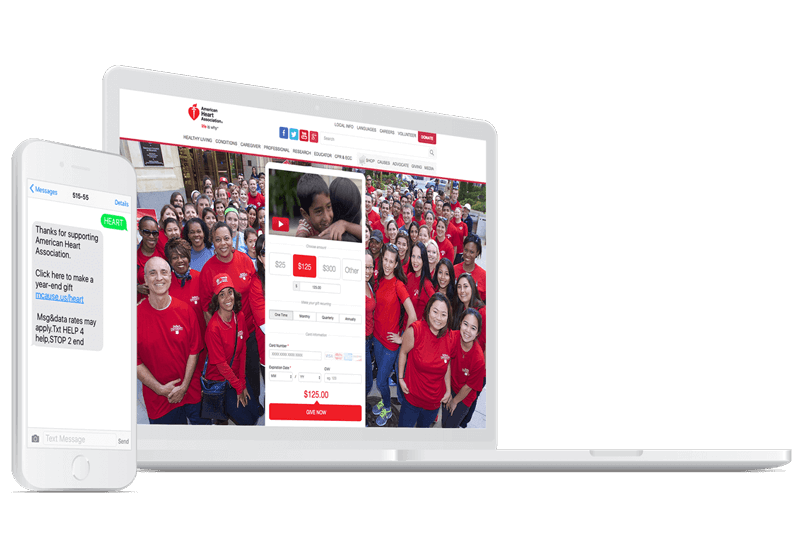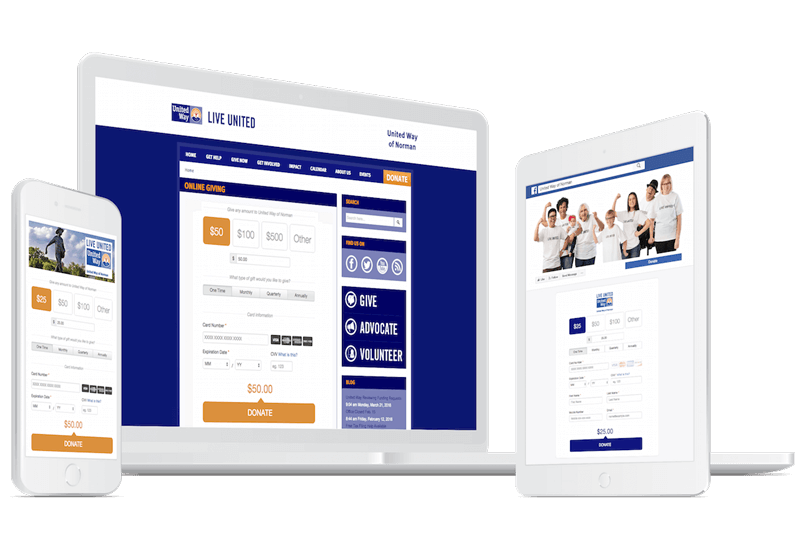Oct 24, 2022
How to Create Capital Campaign Brochures

Now that your nonprofit’s next capital campaign is moving full steam ahead, it’s time to start planning how you’ll market this important fundraiser. One way to get the word out? Consider creating a capital campaign brochure.
Capital campaign brochures do the important legwork of getting your message out to a wide array of potential supporters. These marketing materials are where you house the basics of your campaign and where many donors will learn about your campaign’s mission! The perfect capital campaign brochure is only a few steps away! Let’s dive right in.
Create an Online Capital Campaign Brochure
In this digital age, you might think that creating a capital campaign brochure seems like an outdated way to advertise your fundraiser. In fact, your brochure can serve as a resource for your supporters to consult both on and offline.
As a supplement to your print brochure, your nonprofit should also develop a digital brochure to be housed on your nonprofit’s website. When promoting your campaign online, you can direct prospective donors to the brochure as a resource for important information relating to your campaign just as you would direct donors to your print brochure when speaking to them in person.
When designing your digital brochure, it’s important that your marketing department keeps a few things in mind:
- Make it a PDF. Be sure to design your online brochure as a PDF file. PDF files are easily shareable, high-quality files that are less likely to suffer from formatting issues when being opened in a variety of web browsers, desktops, and mobile devices. They can also contain links, allowing you to direct readers to crowdfunding pages, online donation forms, your organization’s social media platforms, etc.
- Mirror your website. Your capital campaign brochure should directly mirror your nonprofit’s website. In a sense, your organization’s website is like a brochure itself, but with fundraising functionality. Link to your online giving pages wherever possible and be sure to include ample information on your campaign and nonprofit.
- Don’t waste your web potential. Designing your online brochure shouldn’t be as simple as uploading to your website the same file you use to print your regular brochures. Make use of hyperlinks, high-resolution images, and other functionalities that are only possible online. You can even embed or link to videos that comprehensively cover fundraising needs, case statements, or other important information.
See how the American Heart Association seamlessly integrates a video call-to-action into its online donation form? By including a video call-to-action on this page, you’re more likely to motivate supporters to get involved with your capital campaign. In your online capital campaign brochure, you can link out to pages like these to make the most of your digital capabilities.

Final thoughts: Your nonprofit’s online brochure is an incredibly important part of your marketing strategy. Not only does it spread the word of your capital campaign, but it is able to reach a wider audience than traditional print brochures, especially with younger individuals. Don’t let this important resource go to waste!
Develop a Case Statement for your Campaign
For both your nonprofit’s digital and print brochures, it’s important that they clearly communicate your capital campaign’s case statement.
The bulk of the information contained in your brochures should directly make the case for a donor’s support of your campaign in much the same way that your staff, volunteers, or board might do in person.
As you compile the contents of your brochure, your nonprofit should make it a priority to include information such as:
- Your organization’s needs. In your brochure, directly state why your organization is holding a capital campaign. Don’t just say you need to raise money: give supporters a reason why they should get involved (and why they specifically should get involved).
- The goals of your capital campaign. Be specific when communicating your goals. Let supporters know how much money you need to raise, your deadline for raising that money, and any associated goals that might be accomplished over the course of your campaign. Reiterate your organization’s overall mission statement as well as define the specific mission of this capital campaign.
- How meeting those goals facilitates your mission and addresses said needs. How does your capital campaign further the mission of your organization? Your supporters care about your nonprofit because you are dedicated to a cause they are passionate about. Don’t forget why you are here in the first place!
- Challenges to completing the goal. What difficulties are you facing in pursuit of your capital campaign goals? What might be getting in the way of the finish line? Be upfront with potential donors; if they feel like you can’t succeed without their help, they will likely be more willing to get involved.
- How someone can support the capital campaign. It’s not enough to tell people to support your capital campaign. Your brochure needs to give them a step-by-step guide to donating. Similarly, provide suggested gift amounts and show how gifts at those levels can help you reach your goal more quickly.
Check out this example of the type of case statement your team should include when you design your capital campaign’s brochure:
This year, Greenfield Animal Hospital will be expanding to accommodate the influx of new patients we’ve seen over the past several years. In 2022, we received over 350% more patients than in 2021. Due to this unprecedented influx, we found ourselves with a staffing deficit.
We would like to take on several new veterinary physicians but to do so, we need to expand our campus. With the help of our supporters, we want to raise $15,000,000 by November 2022. This will account for moving locations, building the new animal hospital, training new support staff, and hiring additional veterinarians.
At Greenfield, caring for animals with dignity has always been our mission. With your support, we’ll be able to take on more patients and give our existing patients the care they deserve. Will you help us fulfill our mission?
While any gift is welcome, gifts at the following levels will have a significant impact on our project: [Include a graphic such as a gift range chart here to show readers how different gift levels bring you closer to your goal.]
If you would like to donate, you can give using our online donation form or send a check to 1234 Greenfield Lane…
Final thoughts: Your brochure should ultimately make the case to readers as to why they should support your capital campaign. Don’t lose sight of the fact that your brochure needs to convince potential donors to give and not just inform them of the facts of your campaign. Be compelling!
Create a Vision for your Capital Campaign
It’s not enough for your brochure to communicate to readers that your organization is trying to raise money, or that your fundraising goal is important. Your capital campaign’s brochure also needs to outline a vision for your potential supporters.
Potential donors want to know important information like how their money will be spent, when the project will be finished, and how worthy your cause is of their support. Donors will feel confident if your nonprofit can demonstrate that it can successfully manage a project, especially one of the scope of a capital campaign.
This vision of your capital campaign should shine the light on how your organization intends to move forward in pursuit of your goal. Your brochure should make it easy for readers to not only understand exactly how their contributions will be used, but also give them a step-by-step walkthrough of your campaign from start to finish.
Here are a few techniques your nonprofit can use in your brochure to help readers see the path forward for your capital campaign:
- Illustrate your goal (literally). Your brochure can provide visual examples of your completed goal. For example, if your capital campaign is trying to raise funding for a new building, your brochure could include a blueprint or mockup of the structure.
- Break down gift amounts. Not only are gift range charts helpful tools for your nonprofit behind the scenes, but they are also great visual aids. Be sure to include a gift range chart to show potential donors the many levels at which they can contribute and include specific, tangible information on how gifts of those sizes will be used. Your brochure might include a gift range graphic like the one below to illustrate your needs to supporters.

- Include a timeline. To the best of your ability, include a timeline of your capital campaign’s fundraising calendar in the brochure. At the very least, identify an end date for your fundraiser or, for example, the date you intend to break ground on your project. Be sure to identify the stages of your campaign on this timeline as well so that readers can get a better idea of how long it will take to reach your goals.
- Provide a call to action. Don’t forget to provide a clear call to action for major donors. Though you should meet in person with major donors to make your ask, you can use your brochure as an introduction to your request. This gives major donors time to think over their decision, much like donors would review your case for support during a feasibility study.
Final thoughts: Potential donors will be more likely to give if they have a clear understanding of how your capital campaign will play out. Don’t leave your readers with any unanswered questions! Use your brochure to lay out the progression of your capital campaign so that donors can be confident that their support will be meaningful.
Connect your Capital Campaign Brochure to your Fundraising
When designing your capital campaign’s brochure, your nonprofit should make sure that you’re making the most out of the brochure’s real estate.
In other words, don’t just use the brochure to inform readers of your capital campaign: use your brochure to give readers the tools they need to make a donation. The fewer obstacles readers face on their path to giving, the more successful they will be in completing their donation. Make your brochure itself a fundraising tool to help close the gap between “motivated supporters” and “successful donors.”
Consider including some or all of the following to help steer your supporters toward donation:
- Links to your capital campaign website
- Links to a crowdfunding page
- Information on joining a peer-to-peer fundraiser
- Information on donating via text-to-donate
- Event information
- QR codes
Most importantly, your capital campaign brochure should feature direct links or prompts that guide readers to your online donation forms. For an online brochure, simply include a link to this feature. For physical brochures, perhaps those used in direct mail campaigns, you can also include a QR code to bring readers to your donation form.
Keep your online donation form simple and convenient for readers to complete. Check out this donation form from United Way for a great example of what your pages should look like.

Final thoughts: Your capital campaign’s brochure is a powerful resource that should be both informative and actionable. Don’t waste any opportunities to move supporters closer to donation! Be sure that your brochure clearly shows readers how they can donate so that no one is left behind.
Brand your Capital Campaign Brochure
Finally, when creating your capital campaign’s brochure, one of the most useful tools in your arsenal is the cultivation of consistent branding. Your nonprofit’s branding sets your organization apart from the crowd, as well as contributes to the way that potential donors interact with your organization.
Your capital campaign’s brochure should be branded to your organization just as you might brand your website, crowdfunding pages, fundraising events, etc. Branding fosters recognition and familiarity among members of your community, strengthening the bond between donors and your organization.
Some branding strategies your nonprofit may consider include:
- Include branded imagery. Your capital campaign’s brochure should prominently feature several high-quality images that showcase your nonprofit’s mission. These images might also illustrate your campaign’s vision, the community that your nonprofit serves, or various valued supporters.
- Feature your brand’s colors. Your nonprofit should already have 2-3 core colors that are used throughout various branded materials to tie your organization together. Don’t neglect to use these colors in your capital campaign brochure.
- Incorporate your nonprofit’s logos. Be sure to prominently include your nonprofit’s logo throughout your brochure. You want potential donors to associate your capital campaign with your organization’s overall mission and there’s no better way to reaffirm your campaign’s importance to this mission than by strengthening this association.
- Use your organization’s slogans. Your nonprofit might have a slogan that’s used across marketing material. If this is the case, certainly feature the slogan somewhere in the brochure. But in addition, your nonprofit should create a campaign-specific slogan that is used in the brochure to help give the campaign its own memorable identity.
Final thoughts: Although in some ways it’s important to give your capital campaign its own personality, your nonprofit should ultimately make it a priority to relate your campaign to your organization’s identity as much as possible. This will remind readers that your campaign is in service of your nonprofit’s ultimate mission, and not just a one-off project.
We create the campaigns. You focus on running your organization.
Our team of digital marketing experts work hands-on with you on each component of your campaign to ensure it has all the elements of success. From identifying fundraising strategies to campaign setup, we’ll partner with you every step of the way so you can achieve your fundraising goals. Request your demo now!
Related



